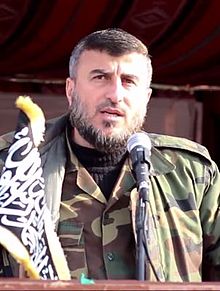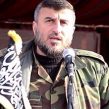
Jaysh al-Islam and the Battle for Damascus
Publication: Terrorism Monitor Volume: 13 Issue: 17
By:

On August 16, a Syrian Air Force raid struck a crowded market place in the capital Damascus’ northeastern suburbs of Douma and Harasta; these suburbs are located in the Ghouta region east of the city, a major center of armed opposition activity. The attack killed over 100 people and drew intense international condemnation (al-Quds al-Arabi, August 17; August 15; L’Orient Le Jour [Beirut], August 13). Also reportedly targeted in the attack was the Douma headquarters of the Damascus area’s most powerful rebel organization, Jaysh al-Islam (JAI—Army of Islam), and its leader Shaykh Zahran Alloush (al-Ayam [Damascus], August 19; Sky News Arabia [Dubai], August 17; for more on Zahran Alloush and Jaysh al-Islam, see Militant Leadership Monitor, October 2013). The attack on JAI underlines that the government’s ongoing confrontation with the group, one of Syria’s most powerful rebel militias, and its allies in the Damascus area is critical for the future of the capital and of Syria itself.
JAI leader Zahran Alloush is one of the most important Syrian armed opposition commanders in the entire civil war, largely due to the size and cohesion of the organization and its strategic location close to the country’s capital, which could have significant implications on the politics of a potential post-Assad Syria. Alloush is a long-time member of Islamist opposition movements in Syria and has expressed a desire to participate in the political order of a potential post-Assad Syria, although in recent public sermons, he has rejected democracy (YouTube, December 21, 2014; Militant Leadership Monitor, October 2013). Alloush has also aired contradictory views on the role of Shari’a in a potential post-Assad state. Additionally, he has made inflammatory comments against Shi’a Muslims, although he has also said that he supports the protection of sectarian minorities, within the context of Shari’a (YouTube, May 23; YouTube, May 21; YouTube, January 6, 2014; YouTube, June 19, 2013).
JAI should be generally regarded as a militant Islamist organization. It and its local allies are believed to have the ability to mobilize 30,000-50,000 fighters and have seized significant numbers of military vehicles, including tanks, from the government’s security forces (al-Jazeera, August 15; Al-Monitor, May 28; YouTube, April 30). [1] JAI and its allies have also demonstrated the continued capability to resist repeated attempts by the security forces, including the elite Republican Guard, to seize opposition-controlled areas in eastern Ghouta (al-Arabi al-Jadeed, May 5; Orient News [Dubai], February 16). [2] JAI has also a significant stockpile of rockets and artillery that it has deployed, and threatens to continue deploying, against loyalist areas in Damascus, Lattakia and Aleppo Governorates (al-Safir [Beirut], August 17; YouTube, August 9; YouTube, July 13; al-Souria [Damascus], January 24).
Alloush is also the commanding officer of the Ghouta Unified Military Command, a coalition of important eastern Ghouta armed opposition groups in which JAI is the most prominent faction; it also includes the groups al-Itihad al-Islami al-Ajnad al-Sham (Islamic Union of the Soldiers of the Levant), Faylaq al-Rahman (Legion of the Most Merciful One), Alwiya al-Habib al-Mustafa (Brigades of the Chosen One) and Harakat Ahrar al-Sham al-Islamiya (YouTube, August 29, 2014; YouTube, August 27, 2014; al-Arabi al-Jadeed, August 23, 2014; Militant Leadership Monitor, June 2015). The Ghouta Unified Military Command, and Jaysh al-Islam in particular, are arguably the most important factor restricting the growth of the Islamic State and al-Qaeda’s Syria front, Jabhat al-Nusra (JAN) within the Damascus area. [3] Under Alloush’s command, JAI has been a particularly implacable opponent of the Islamic State, and it generally directs the Ghouta area’s armed opposition groups to block the Islamic State’s expansion (Arabi 21 [Damascus], July 9; al-Arabiya, July 1; El-Dorar al-Shamiya [Beirut], July 1; YouTube, July 3, 2014; Militant Leadership Monitor, July 2014). Alloush’s role as the Damascus area’s most powerful rebel commander and an opponent of the Islamic State and JAN is believed to have helped attract the attention and diplomatic outreach to him by powerful regional anti-Assad states, including Saudi Arabia and Turkey, and other actors such as Jordan (El-Dorar al-Shamiya [Beirut], July 20; al-Arabi al-Jadeed, April 21; al-Safir [Beirut], April 20; Rai al-Youm [Amman], December 10, 2014).
However, in spite of the challenge to the Syrian government presented by the Ghouta Unified Military Command under Alloush’s leadership, the Syrian Army is nonetheless conducting a slow, but increasingly successful, war of siege and attrition against JAI and other armed groups in the Damascus area; the same thing is happening in the city of Zabadani, located 50 kilometers northwest of the capital on the strategic Damascus-Beirut highway (al-Safir [Beirut], August 18; al-Arabiya, August 18; al-Nahar [Beirut], August 18; al-Arabi al-Jadeed, August 18; al-Jazeera, August 16). In addition, the supply lines of JAI and its allies, which run from Ghouta north to Turkey and west to Lebanon, are severely strained by Islamic State operations in the eastern Qalamoun region northeast of Damascus, particularly in the town of al-Qaryatayn. [4] In response, JAI is attacking the Islamic State in the eastern Qalamoun, with the assistance of a coalition of local rebel factions that it is coordinating (Arabi 21, August 12; al-Arabi al-Jadeed, July 2). [5]
The Assad government’s strategy in Damascus is to create incredible pressure on rebel areas through siege warfare, including highly destructive artillery bombardments and air raids, followed by the offer of release from suffering through the cessation of hostilities and the potential incorporation of surrendering rebel fighters into loyalist security forces and militias. [6] An example of this type of rebel-turned-loyalist militia is Jaysh al-Wafa (Loyalist Army), created via the government’s “Reconciliation Committees” (al-Masdar [Damascus], March 13; al-Akhbar [Beirut], February 9; al-Safir [Beirut], January 29; al-Safir [Beirut], May 15, 2014; al-Akhbar [Beirut], February 21, 2014). [6] Jaysh al-Wafa, in particular, poses a significant challenge to JAI and its allies, due to its direct attacks against them and the potential model it could present for the suffering population of the eastern Ghouta, prompting JAI to recently capture and later execute the leader of Jaysh al-Wafa (al-Masdar [Damascus], June 16; al-Jazeera, May 25; al-Akhbar [Beirut], February 9). [8]
An additional challenge for JAI and its allies is that government forces are present in great numbers in Damascus, enjoy heavier weaponry, including an air force, and have thus far had more secure lines of supply and reinforcement. These government forces include regular and elite Syrian Army units, neighborhood-level paramilitary militias under the Quwat al-Difa al-Watani (National Defense Force—NDF), Hezbollah and predominately Iranian Revolutionary Guard Corps (IRGC)-mobilized Shi’a groups (AFP, July 25; al-Souria Net [Damascus], July 12; al-Arabiya, March 31; al-Jazeera, January 14; al-Sharq al-Awsat, April 8, 2014; Reuters, February 21, 2014; Militant Leadership Monitor, June 2013; Terrorism Monitor, May 2, 2013). The government’s advantage in being able to put heavy pressure on the armed opposition in this manner has direct impact on the state of civil society and internal security in opposition-controlled areas around Damascus, which threatens the position of JAI and its allies as the leading civil-military force in the area. Protests against Alloush and other rebel groups are frequent in eastern Ghouta, mainly focusing on alleged corruption, mismanagement or hoarding of essential goods intended for the area’s civilians, a repressive rebel security apparatus that includes imprisonment without charges, sporadic factional rebel infighting and the inability of the Ghouta Unified Military Command to break al-Assad military sieges (All4Syria [Damascus], August 16; Arabi 21, August 10; All4Syria [Damascus], August 8; YouTube, July 27; al-Quds al-Arabi, July 1; YouTube, June 19; Arabi 21, May 30; Orient News [Dubai], May 30; YouTube, January 25; YouTube, November 17, 2014).
Thus, JAI faces an ongoing threat to its position as the leading civil-military force in the largest Damascene rebel-controlled area, due to the government’s siege warfare strategy and growing discontent of the population that JAI and its allies claim authority over. The Islamic State is a looming threat, actively challenging JAI and its allies’ supply lines and presenting a potentially appealing ideological alternative as civilian discontent over JAI and its allies’ rule grows. Managing these challenges will continue to test the leadership abilities of Alloush, who is already operating under considerable pressure.
The struggle for the Damascus region between the government and opposition forces, such as JAI, is important as its outcome will help establish the parameters of any potential future negotiation for a post-conflict Syria. Accordingly, the Syrian government is focusing heavily on attacking rebel forces in the region as well as undertaking other measures, such as population transfers, as recently demonstrated by reported Zabadani, Fuaa and al-Kefraya population exchanges, which are apparently aimed at securing the demographic future of an Assad-led statelet in western Syria; such a statelet would continue to function as a strategic ally of the IRGC. The Assad government and its allies currently remain sufficiently well entrenched in the capital and its environs to set the terms of any future negotiations over the region. However, Zahran Alloush, assuming he survives and that JAI and its allies can maintain their territories in the eastern Ghouta, is also well positioned to be the most significant rebel leader in any such negotiations or a post-war scenario.
Nicholas A. Heras is a Middle East researcher at the Center for a New American Security (CNAS) and an associate fellow for The Jamestown Foundation.
Notes
1. Author’s personal interviews with Syrian activists from the Damascus area in Washington, DC, on December 9, 2014, June 8, 2015, August 11, and August 18, 2015.
2. Many of these are documented on the group’s Twitter account https://twitter.com/islamarmy01.
3. Op cit., personal interviews.
4. Ibid; author’s Skype conversation with a leader in Jaysh Asuud al-Sharqiya, who is based in Gaziantep, Turkey, August 11, 2015.
5. Among the rebel groups that are participating in the coalition coordinated by JAI in the eastern Qalamoun area is Jaysh Asuud al-Sharqiya (Army of the Lions of the East). Jaysh Asuud al-Sharqiya is a constituent faction within the Syrian Islamist national umbrella organization Jabhat Asala wal-Tanmiya (Authenticity and Development Front), which was originally mobilized in Deir al-Zor Governorate in eastern Syria near the Syrian-Iraqi border. The majority of its fighters were displaced from Deir al-Zor over the last year as the Islamic State consolidated its rule over that governorate. Jaysh Asuud al-Sharqiya has reportedly begun to receive some military support, weapons and ammunition from JAI, although it seeks to remain distinct from Alloush’s organization. This assistance, although limited, is reportedly being provided in order to provide a line of supply from the eastern Qalamoun into Deir al-Zor Governorate, where approximately 1,000 fighters from different militias affiliated with Jabhat Asala wal-Tanmiya continue to provide resistance against the Islamic State. However, Jaysh Asuud al-Sharqiya is not a significant rebel actor in the battle for control over the Damascus area; Author’s Skype conversation with a leader in Jaysh Asuud al-Sharqiya who is based in Gaziantep, Turkey, August 11, 2015.
6. Amnesty International accuses armed opposition groups, especially JAI, as well as the government, of committing war crimes against the civilian population, estimated to be more than 163,000 people, of the eastern Ghouta. JAI and its allies in the Ghouta Unified Military Command are particularly accused of manipulating the price of necessary existential goods, hoarding these goods, running a repressive security and detention system and directly targeting civilian, loyalist communities with artillery and rocket barrages. See: Amnesty International, “‘Left to Die Under Siege’: War Crimes and Human Rights Abuses in Eastern Ghouta, Syria,” August 2015, https://www.amnestyusa.org/sites/default/files/mde2420792015english.pdf.
7. Author’s interviews with Syrian activists from Damascus area in Washington, DC, on December 9, 2014, June 8, 2015, August 11, and August 18, 2015.
8. Ibid.





